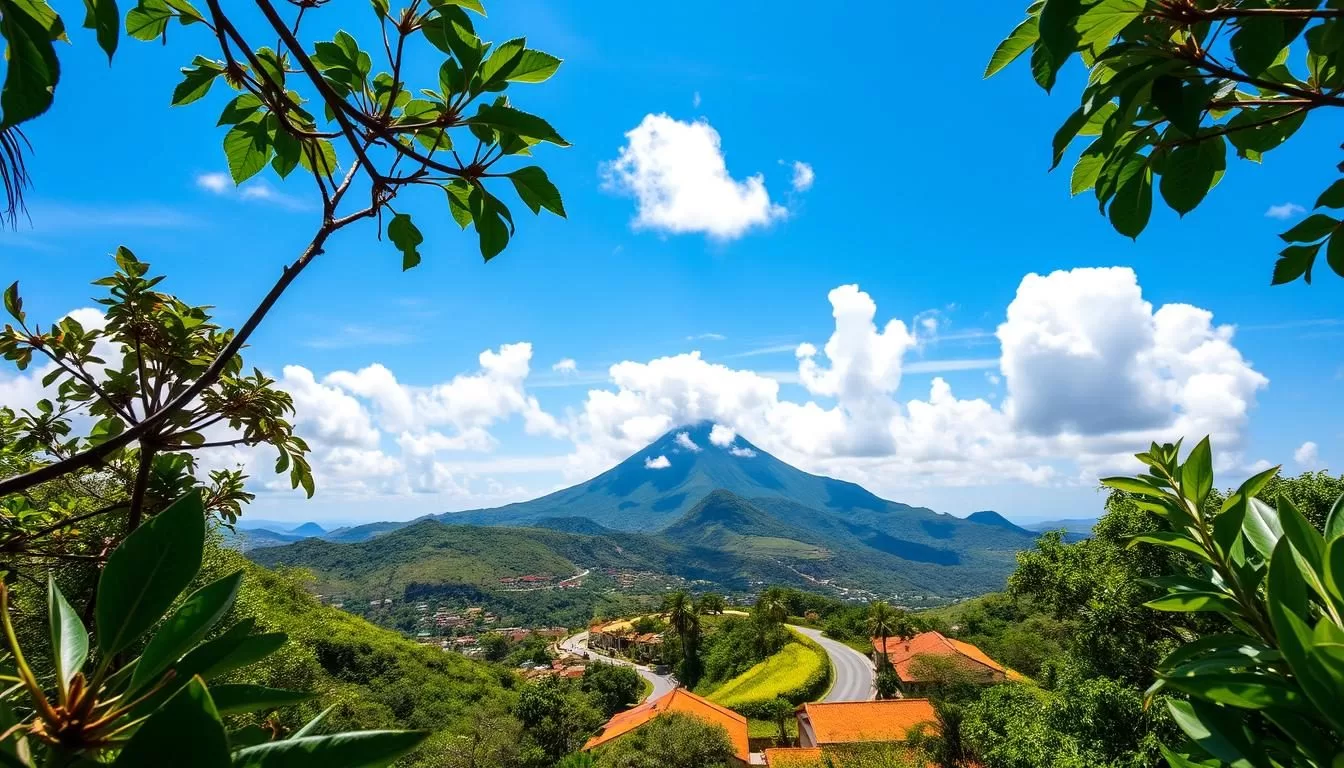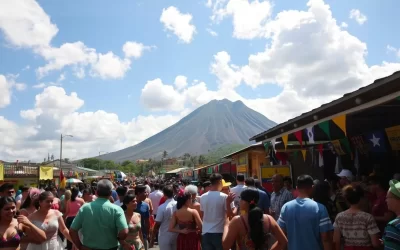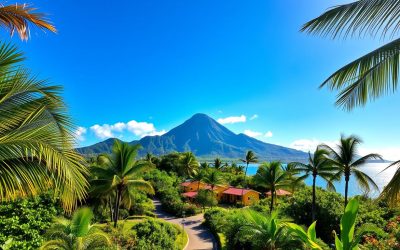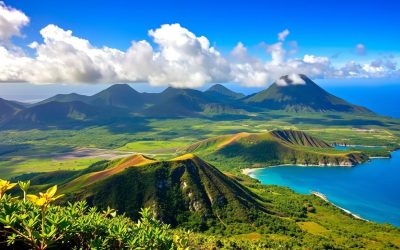✓ Accommodations✓ Flights✓ Rental Cars
Welcome to Montserrat, a small but vibrant island in the Caribbean. Here, language plays a key role in shaping daily life. The official language is English, used in government, education, and business. This reflects the island’s historical ties to the British Empire.
Beyond English, you’ll hear Creole dialects spoken by the population. These dialects showcase the island’s rich cultural tapestry. They blend African, Irish, and Caribbean influences, creating a unique linguistic heritage.
Montserrat’s landscape is as diverse as its languages. From lush hills to volcanic peaks, the island offers breathtaking views. Its small number of residents adds to its close-knit community feel.
Understanding the influence of language here helps you appreciate the island’s culture. Ready to learn more? Let’s dive deeper into Montserrat’s fascinating heritage.
Introduction to Montserrat’s Language Heritage
Montserrat’s language heritage is a fascinating blend of history and culture. The way people communicate here reflects centuries of influence and adaptation. From everyday conversations to formal settings, language plays a vital role in shaping the island’s identity.
Why Languages Define Culture on the Island
Language is more than just a tool for communication—it’s a source of cultural pride. In Montserrat, the mix of English and Creole dialects showcases the island’s diverse roots. These dialects are a testament to the resilience and creativity of its people.
For a child growing up here, language is a gateway to understanding their heritage. It connects them to their ancestors and the stories of the past. This cultural richness is evident in local traditions, music, and even daily activity.
An Overview of Montserrat’s Linguistic Diversity
Montserrat’s linguistic landscape is shaped by its history. English, the primary language, is used in government, education, and public life. However, Creole dialects add a unique flavor to everyday conversations.
Historical events, such as migration and colonization, have influenced language use over time. For example, the arrival of African and Irish settlers introduced new expressions and dialects. Today, these influences are woven into the fabric of Montserrat’s identity.
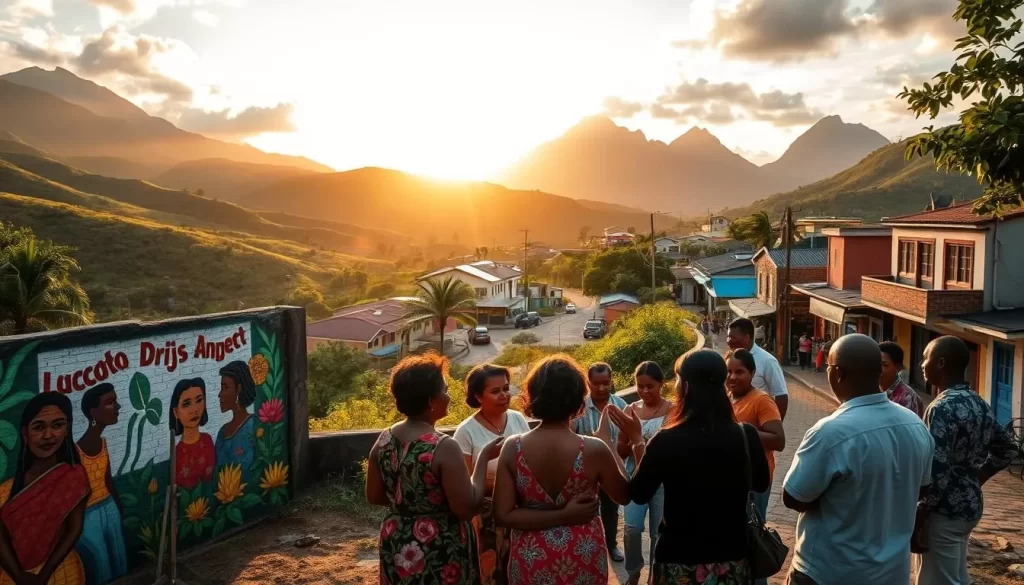
Here’s a quick look at how languages are used in different aspects of life:
| Context | Primary Language | Secondary Language |
|---|---|---|
| Government | English | Creole |
| Education | English | Creole |
| Daily Conversations | Creole | English |
| Cultural Events | Creole | English |
Understanding this linguistic diversity helps you appreciate the island’s culture. Whether you’re visiting or learning about Montserrat, its languages offer a window into its soul.
Official Language: English in Montserrat
English holds a central role in the daily life of this Caribbean island. It is the primary language used in government, education, and public communication. This reflects the island’s historical ties to the British Empire and its colonial past.
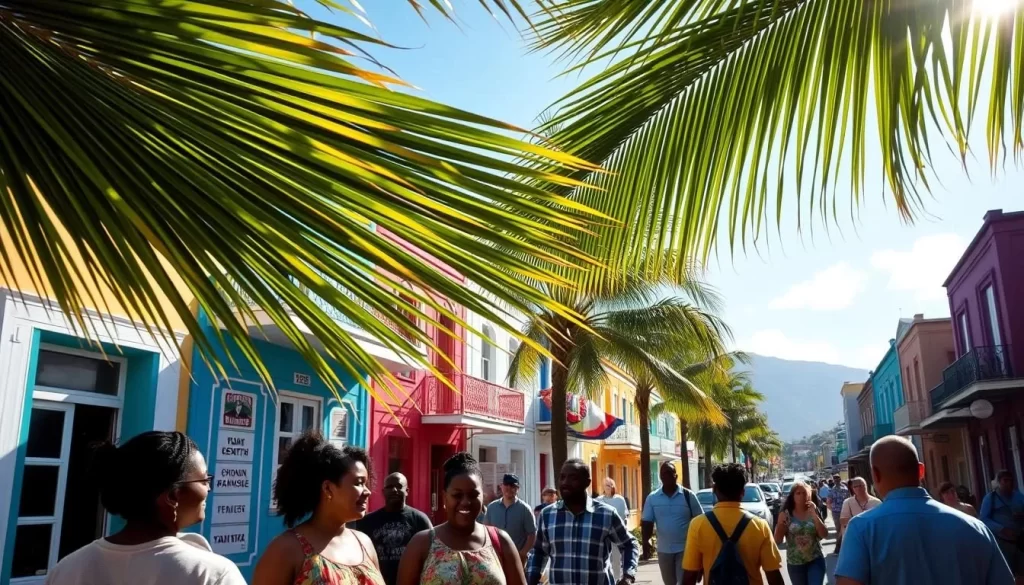
Government and Education Use
In government operations, English is the standard for official documents, laws, and public announcements. Schools also use it as the medium of instruction, ensuring students are fluent in the official language. This consistency helps maintain clarity and efficiency in civic institutions.
Cultural and Historical Importance
Beyond its practical uses, English carries cultural significance. It connects the population to their colonial history while serving as a tool for modern communication. This dual role highlights its importance in preserving the island’s identity.
Globally, English is recognized as an official language in 58 countries. Its status in Montserrat aligns with this trend, showcasing the island’s integration into the broader world. Understanding this helps you appreciate the role of language in shaping societies.
Montserrat: Official and widely spoken languages
Language on the island tells a story of resilience and adaptation. From official settings to casual chats, the way people communicate reflects their history and culture. This section dives into the role of Montserrat Creole, its differences from English, and how migration has shaped its evolution.
Understanding the Role of Montserrat Creole
Montserrat Creole is more than just a dialect—it’s a cultural cornerstone. Rooted in African, Irish, and Caribbean influences, it’s a living testament to the island’s heritage. For a child growing up here, Creole is a bridge to their ancestors and a way to express local identity.
This dialect thrives in daily conversations, music, and storytelling. It’s a reminder of the island’s past and a symbol of its enduring spirit. Understanding Creole helps you connect with the heart of Montserrat’s culture.
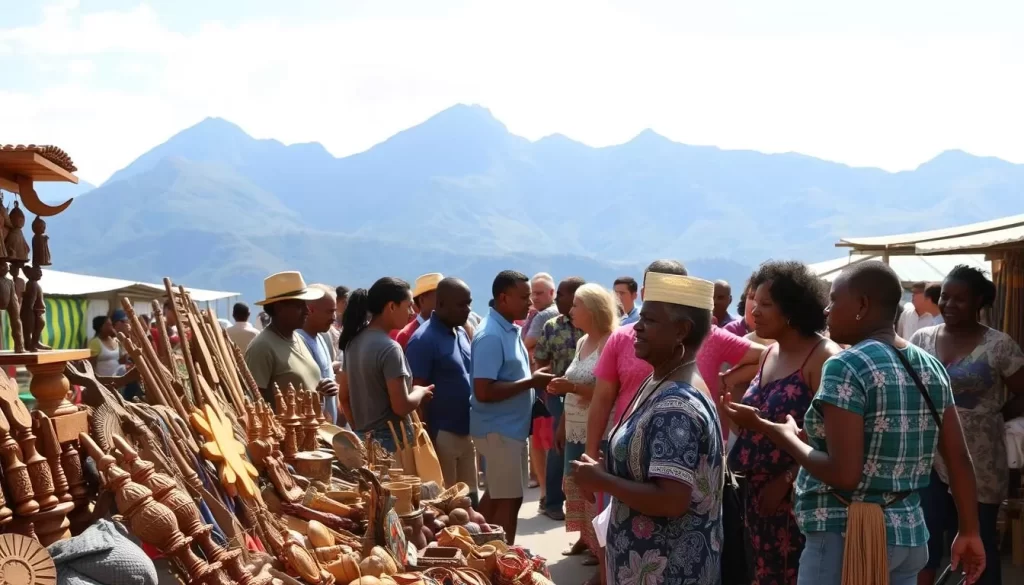
Comparing English and Creole in Daily Life
English and Creole coexist harmoniously on the island. While English dominates government and education, Creole is the language of the streets and homes. This balance reflects the island’s dual identity—global yet deeply local.
Here’s how the two languages are used:
- Formal Settings: English is preferred in schools, offices, and official documents.
- Casual Conversations: Creole is the go-to for friendly chats and cultural events.
- Cultural Expressions: Music, proverbs, and storytelling often feature Creole.
The Impact of Migration on Language Use
Migration has played a key role in shaping the island’s linguistic landscape. The arrival of African and Irish settlers introduced new dialects and expressions. Over time, these influences blended with local traditions, creating the unique Creole spoken today.
Historical events, like the Soufrière Hills eruption, also impacted language use. Displacement and resettlement brought new interactions, further enriching the island’s linguistic diversity. Today, Montserrat’s languages are a testament to its resilience and adaptability.
Historical Overview of Montserrat’s Linguistic Landscape
The linguistic history of this Caribbean gem reveals a story of resilience and transformation. Over centuries, the way people communicate here has been shaped by colonial influences and natural disasters. This section explores how these events have left a lasting imprint on the island’s language and culture.

Colonial Influences and Language Introduction
Colonialism played a key role in shaping the island’s linguistic identity. English became the dominant language due to British rule, used in government, education, and public life. However, the arrival of African and Irish settlers introduced Creole dialects, blending diverse cultural influences.
These dialects became a source of cultural pride, reflecting the island’s unique heritage. For many, speaking Creole is a way to connect with their ancestors and preserve local traditions. This dual linguistic identity remains a defining feature of the island’s life.
Post-Eruption Language Shifts
The Soufrière Hills eruption in 1995 marked a turning point. Nearly two-thirds of the population was displaced, leading to significant changes in language use. Many residents relocated to other countries, exposing them to new dialects and expressions.
This migration enriched the island’s linguistic activity, blending local Creole with global influences. Today, the status of English as the official language remains, but Creole continues to thrive in daily conversations and cultural events. These shifts highlight the island’s adaptability and resilience.
Living Language: Everyday Phrases and Creole Expressions
Exploring the everyday language of Montserrat offers a glimpse into its vibrant culture. From greetings to casual conversations, the way people speak reflects the island’s rich heritage. This section dives into popular Creole expressions, English-Spanish exchanges, and practical phrases for visitors.
Popular Creole Expressions Explained
Creole is more than just a dialect—it’s a window into the island’s soul. Phrases like “Wha’ gwan?” (What’s going on?) and “Mi deh yah” (I’m here) are staples in daily conversations. These expressions carry cultural meanings, often rooted in African and Irish influences.
For a child growing up here, these phrases are a way to connect with their heritage. They’re used in storytelling, music, and even humor, making them an integral part of the island’s identity.
English-Spanish Exchanges in Daily Conversation
While English dominates formal settings, Spanish often pops up in casual chats. This is due to the island’s proximity to Spanish-speaking countries and the influence of tourism. Phrases like “Hola, ¿cómo estás?” (Hello, how are you?) are commonly heard in markets and tourist spots.
This blend of languages showcases the island’s adaptability and global connections. It’s a testament to how tourism and migration shape communication.
Practical Phrases for Visitors
If you’re planning a trip, learning a few phrases can enhance your experience. Here are some useful ones:
- Greetings: “Good morning” or “Howdy” (Hello).
- Common Questions: “Where is the beach?” or “How much does this cost?”
- Requests: “Can you help me?” or “Where’s the restroom?”
These phrases not only help you navigate the island but also show respect for the local culture. Whether you’re exploring the economy or enjoying the beaches, language is your bridge to meaningful connections.
Geographic and Social Impact on Language Usage
Natural events have played a pivotal role in shaping the way people communicate here. The island’s unique geography, marked by volcanic activity and rugged terrain, has influenced its linguistic evolution. These factors have not only affected daily life but also reshaped the language landscape over time.
Volcanic Eruptions and Population Movements
The Soufrière Hills eruption in 1995 was a turning point for the island. Nearly two-thirds of the population was displaced, leading to significant changes in how people speak. Many residents relocated to other regions, exposing them to new dialects and expressions.
This migration enriched the local language, blending traditional Creole with global influences. For a child growing up during this time, language became a bridge between the past and the present. These shifts highlight the resilience of the island’s cultural identity.
The rugged landscape also plays a role in shaping communication. Living in a challenging environment fosters a close-knit community, where language reflects shared experiences. This connection between geography and culture is evident in everyday conversations and storytelling.
Interactions with neighboring West Indies cultures have further enriched the linguistic tapestry. Trade, tourism, and migration have introduced new words and phrases, creating a dynamic blend of dialects. This cultural exchange continues to shape the way people communicate on the island.
Understanding these influences helps you appreciate the island’s unique life and heritage. From volcanic events to cultural exchanges, the story of language here is one of adaptation and resilience.
Language Diversity and Cultural Influence in the West Indies
The West Indies is a melting pot of cultures, each leaving its mark on the region’s languages. From English and Spanish to Creole dialects, the linguistic landscape here is as diverse as its people. This diversity is a testament to centuries of shared history, migration, and cultural exchange.
Neighboring Islands and Shared Linguistic Traits
Geographical proximity and shared history have created common linguistic traits across the West Indies. For example, English is widely spoken in islands like Jamaica and Barbados, while Spanish dominates in Puerto Rico and the Dominican Republic. Creole dialects, influenced by African and European languages, are also prevalent.
These similarities make it easier for a child growing up in one island to understand the language of another. It also fosters a sense of regional identity, connecting people across borders.
The Role of Tourism in Language Evolution
Tourism has significantly influenced language patterns in the West Indies. As visitors from around the world flock to the region, they bring new words and expressions. This interaction enriches the local language, blending traditional dialects with global influences.
For instance, phrases from Spanish, French, and even Dutch have found their way into everyday conversations. This evolution highlights the adaptability of the population and their openness to cultural exchange.
Understanding these dynamics helps you appreciate the rich linguistic heritage of the West Indies. Whether you’re exploring the islands or learning about their history, language is a window into their soul.
Conclusion
The story of language on this island reflects its resilience and adaptability. From colonial influences to the Soufrière Hills eruption, historical and natural events have shaped how people communicate. English remains central in government and education, while Creole thrives in daily life and cultural expressions.
Population shifts, driven by volcanic activity, have enriched the linguistic landscape. These changes highlight the island’s ability to adapt while preserving its heritage. Language here is more than a tool—it’s a bridge between the past and the present.
In today’s global world, the island’s linguistic status continues to evolve. It serves as a reminder of the enduring power of culture and communication. To explore more about unique cultural landmarks, visit the Montserrat Monastery, a symbol of resilience and heritage.
The above is subject to change.
Check back often to TRAVEL.COM for the latest travel tips and deals.
